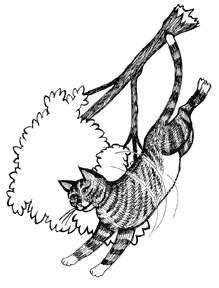STRANGE BUT TRUE- Cat trick: Twisting their way to safety

Q. How do cats pull off "the amazing cat trick" of getting into position to land on their feet after falling or being dropped from any angle? J. Fariello
A. Without having anything to push off or twist against, the cat extends its rear legs and twists the front half of its body toward the ground, says exploratorium.edu. The cat's rear half rotates the opposite way, but not as far, thus conserving angular momentum. Then the cat extends its front legs and twists its tucked rear legs toward the floor. "By repeating these motions, the cat may gain sufficient net rotation to land with its paws on the ground."
Miscellaneous aside: "I have had physicists tell me that cats without tails cannot do the trick," says UC Santa Cruz mathematician Richard Montgomery. "This is false. Manx cats can do it fine. One computes that if the trick were due to the tail, it would have to whip around about 50 times to flip the cat."
Flexible humans can rotate with no angular momentum as well, says Harvard physicist Eric Heller. NASA has video of astronauts starting stock still, then rotating outstretched arms to alter body orientation. "I once saw an astronaut scissor his legs so as to wind up 90 degrees rotated," says Heller.
Ice skaters, skateboarders, gymnasts, dancers, divers all use the principle, adds Montgomery. Even children can learn it. But probably not rhinoceroses, "though there was a great 'Far Side' comic with scientists trying to see if rhinos could do the cat trick."
Q. How big has the "Big Swing in Gender Roles" been over the last half century? –S. Rhoads
A. It's been dramatic, says David G. Myers in Social Psychology, as American approving of a married woman earning money in business or industry has gone from 1 in 5 (1938) to 2 in 5 (1967) to 4 in 5 (2002).
The percentage of 40-year-old married women in the workforce went from 38 percent (1960) to 75 percent (1999–the US, Canada, Britain, Australia). The percentage of female Harvard Business School graduates went from 0 percent (1965) to 30 percent (2000). The proportion of women US medical and law school graduates went from 6 percent and 3 percent (1960) to 43 percent and 45 percent (2000). The percentage of Americans agreeing it's okay for a girl to telephone a boy to ask for a date went from 29 percent (1950) to 70 percent (1999).
Back in the mid-1960s, American wives devoted seven times as many hours to housework as did their husbands, down to twice as many hours by the mid- 1990s. "This striking variation of roles across cultures and over time signals that evolution and biology do not fix gender roles: Culture also bends the genders."
Q. Centenarians you know about, but how about semi- centenarians and supercentenarians? –A. R. Ta'Bois
A. The semis live to age 105, the supers 110. Centenarians number around 200,000, with a mere handful making it to 110– maybe 60-70 at the moment, reports New Scientist magazine. The number has grown since the mid-'60s, when only three had ever been validated. The superest of the superannuated was Jeanne-Louise Calment, who died in 1997 at age 122.
Obviously, very few supers reach 115: as of February '06, the oldest was Maria Capovilla, 116, of Ecuador, the last recognized survivor of the 1880s. But such numbers are always hard to confirm.
Any secrets to joining this elite club? Actually, there's not much you can do but try for a happy, healthful life, taking advantage of today's improved sanitation, nutrition and medicine– the likely reason the supers number is growing– and hope you fit the profile, says New Scientist: First-borns are more likely to make it, as are those born in December (not June) and those (U.S. stats) growing up in rural areas, with literate, home-owning parents. Still unresolved: do genes or the environment count for more?
Q. Blah. Blah. Blah. We humans sure know how to shoot the breeze. Besides skyrocketing sales for cell phone companies, is there any great value to all this talking? –A. G. Bell
A. Look at the classic "homunculus," or "little man," of physiology text books, to see how huge the human brain area is devoted to our tongues, lips, mouths in general. Language likely evolved in stages, first simple calls, then naming things, then representing ideas, says Mahlon Hoagland in Exploring the Way Life Works, The
Science of Biology. One idea led to another, sparking our species' brain circuitry, which in turn opened up new modes of comprehension. "It has been said that not only did we invent language, but language invented us," says Hoagland.
The evolution of consciousness followed, probably within the last 10,000 years, as both a sense of "self" and "time" emerged. The "me" arrived, with all of our individual dramas, and then networking minds. From awareness of past, present and future came agriculture, calendars, and the ability to imagine how life might be though isn't yet, says Hoagland. This brought the gift of choice and free will– both individually and as a species– with consequences as yet unimagined.
Send Strange questions to brothers Bill and Rich at [email protected].
#